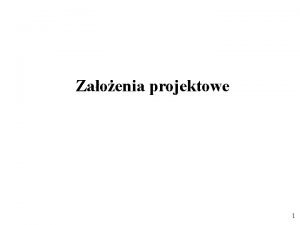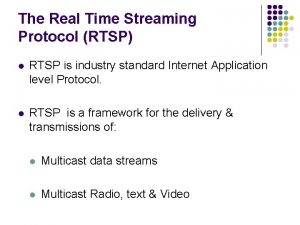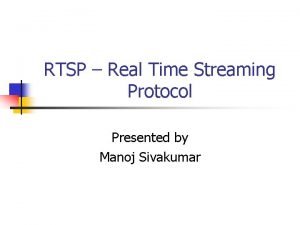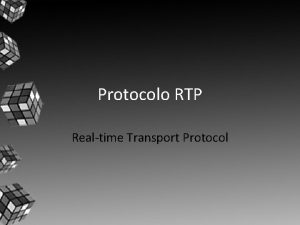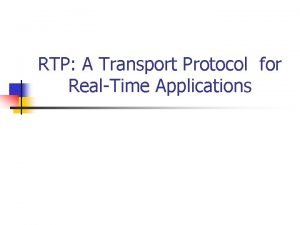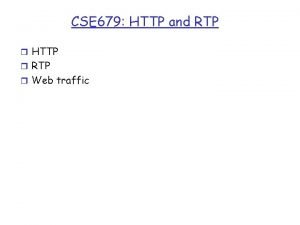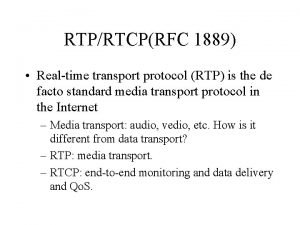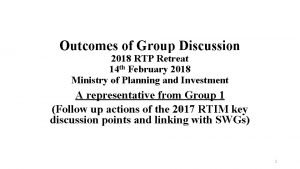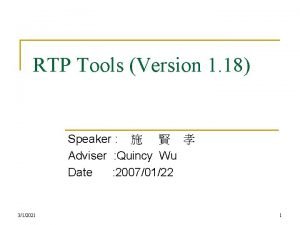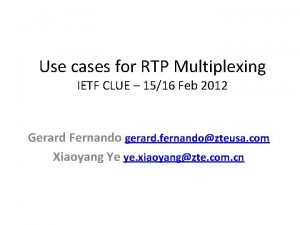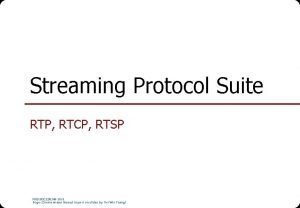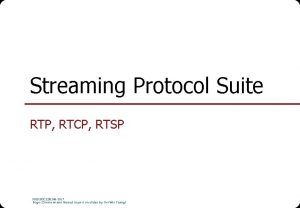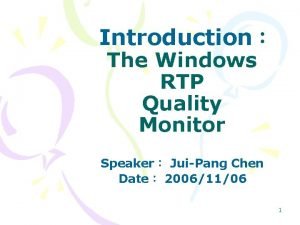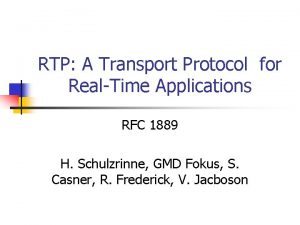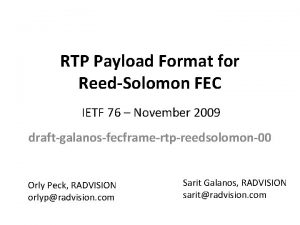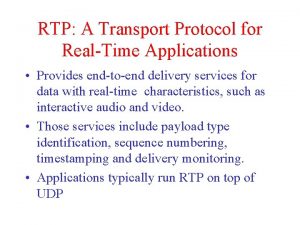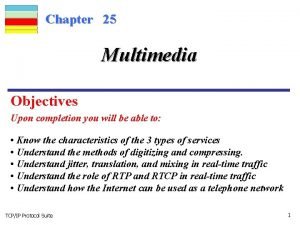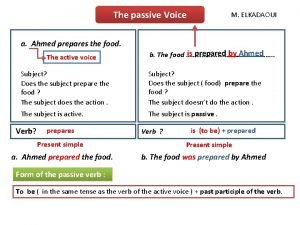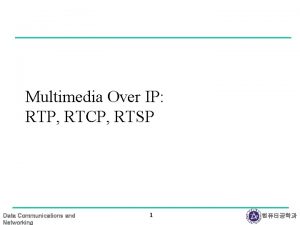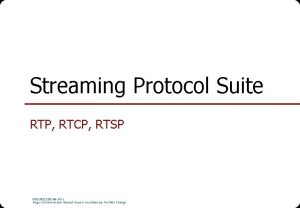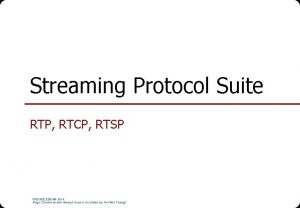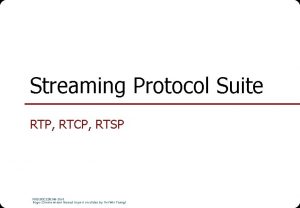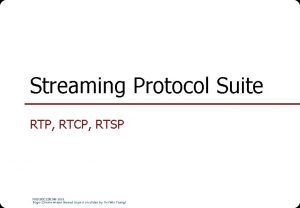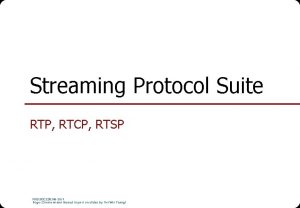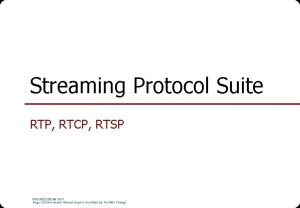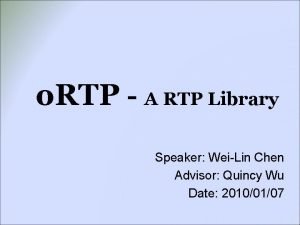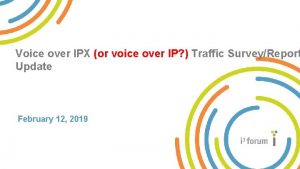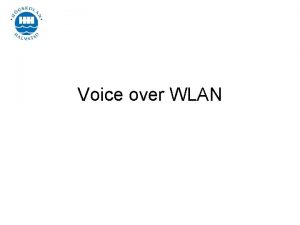THE VOICE OVER INTERNET PROTOCOLVOIP RTP RTSP Presented































- Slides: 31

THE VOICE OVER INTERNET PROTOCOL(VOIP)/ RTP/ RTSP Presented by: Yuvraj Khadke CISC 856: TCP/IP and Upper Layer Protocols 11/29/2012 Credits to: Christopher Thorpe, Varsha Mahadevan, Kevin Jeffay, James F. Kurose, Keith W. Ross

Reasons for VOIP’s growth • Demand for multimedia communication. • Demand for integration of voice and data networks. • Demand for greater flexibility. • Cost reduction in long distance telephone calls.

Voice-over-IP (Vo. IP) • Vo. IP end-delay requirement: needed to maintain “conversational” aspect – higher delays noticeable, impair interactivity – < 150 msec: good – > 400 msec bad – includes application-level (packetization, playout), network delays • value-added services: call forwarding, screening, recording

Vo. IP characteristics • speaker’s audio: alternating talk spurts, silent periods. – 64 kbps during talk spurt – pkts generated only during talk spurts – 20 msec chunks at 8 Kbytes/sec: 160 bytes of data • application-layer header added to each VOIP PDU • VOIP PDU+header encapsulated into UDP or TCP SDU • application sends VOIP PDU into socket every 20 msec during talkspurt

Vo. IP: PDU loss, delay vnetwork loss: IP PDU lost due to network congestion (router buffer overflow) vdelay loss: IP PDU arrives too late for playout at receiver § delays: processing, queueing in network; endsystem (sender, receiver) delays § typical maximum tolerable delay: 400 ms vloss tolerance: depending on voice encoding, loss concealment, PDU loss rates between 1% and 10% can be tolerated

constant bit rate transmission variable network delay (jitter) client playout delay client reception constant bit rate playout at client buffered data Cumulative data Delay jitter time v end-to-end delays of two consecutive PDU’s: difference can be more or less than 20 msec (transmission time difference)

Vo. IP: fixed playout delay • receiver attempts to playout each VOIP PDU exactly q msecs after chunk was generated. – VOIP PDU has time stamp t: play out chunk at t+q – VOIP PDUarrives after t+q: data arrives too late for playout: data “lost”

Vo. IP: fixed playout delay § § sender generates PDU’s every 20 msec during talk spurt. first PDU received at time r first playout schedule: begins at p second playout schedule: begins at p’

Adaptive playout delay (1) vgoal: low playout delay and low late loss rate vapproach: adaptive playout delay adjustment: § estimate network delay, adjust playout delay at beginning of each talk spurt di = (1 -a)di-1 + a (ri – ti) delay estimate after ith PDU small constant, e. g. 0. 1 time received - time sent (timestamp) measured delay of ith PDU

Adaptive playout delay (2) vif no loss, receiver looks at successive timestamps § difference of successive stamps > 20 msec -->talk spurt begins. vwith loss possible, receiver must look at both time stamps and sequence numbers § difference of successive stamps > 20 msec and sequence numbers without gaps --> talk spurt begins.

Voi. P: recovery from PDU loss (1) Challenge: recover from PDU loss given small tolerable delay between original transmission and playout v each ACK/NAK takes ~ one RTT v alternative: Forward Error Correction (FEC) § send enough bits to allow recovery without retransmission simple FEC v for every group of n PDU’s , create redundant PDU by exclusive OR -ing n original PDU’s v send n+1 PDU’s, increasing bandwidth by factor 1/n v can reconstruct original n PDU’s if at most one lost chunk from n+1 PDU’s, with playout delay

Voi. P: recovery from PDU loss (2) another FEC scheme: v “piggyback lower quality stream” v send lower resolution audio stream as redundant information v non-consecutive loss: receiver can conceal loss v generalization: can also append (n-1)st and (n-2)nd low-bit rate chunk

Voi. P: recovery from PDU loss (3) interleaving to conceal loss: v audio VOIP PDU’s divided into smaller units, e. g. four 5 msec units per 20 msec audio VOIP PDU v PDU contains small units from different VOIP PDU’s v if PDU lost, still have most of every original VOIP PDU v no redundancy overhead, but increases playout delay

Real-Time Protocol (RTP) v RTP specifies PDU structure for PDU’s carrying audio, video data v RTP PDU provides § payload type identification § PDU sequence numbering § time stamping v RTP PDU’s encapsulated in UDP SDU v interoperability: if two Vo. IP applications run RTP, they may be able to work together

RTP runs on top of UDP RTP libraries provide transport-layer interface that extends UDP: • port numbers, IP addresses • payload type identification • PDU sequence numbering • time-stamping

RTP example: sending 64 kbps PCM-encoded voice over RTP v application collects encoded data in VOIP PDU’s, e. g. , every 20 msec = 160 bytes in a chunk v audio VOIP PDU’s + RTP header form RTP PDU, which is encapsulated in UDP SDU v RTP header indicates type of audio encoding in each PDU § sender can change encoding during conference v RTP header also contains sequence numbers, timestamps

RTP and Qo. S v. RTP does not provide any mechanism to ensure timely data delivery or other Qo. S guarantees v. RTP encapsulation only seen at end systems (not by intermediate routers) § routers provide best-effort service, making no special effort to ensure that RTP PDU’s arrive at destination in timely matter

RTP header payload type sequence number type time stamp Synchronization Source ID Miscellaneous fields payload type (7 bits): indicates type of encoding currently being used. If sender changes encoding during call, sender informs receiver via payload type field Payload type 0: PCM mu-law, 64 kbps Payload type 3: GSM, 13 kbps Payload type 7: LPC, 2. 4 kbps Payload type 26: Motion JPEG Payload type 31: H. 261 Payload type 33: MPEG 2 video sequence # (16 bits): increment by one for each RTP PDU sent v detect PDU loss, restore PDU sequence

RTP header payload type sequence number type time stamp Synchronization Source ID Miscellaneous fields vtimestamp field (32 bits long): sampling instant of first byte in this RTP data PDU § for audio, timestamp clock increments by one for each sampling period (e. g. , each 125 usecs for 8 KHz sampling clock) v. SSRC field (32 bits long): identifies source of RTP stream. Each stream in RTP session has distinct SSRC

Real-Time Control Protocol (RTCP) v works in conjunction with RTP v each participant in RTP session periodically sends RTCP control PDU’s to all other participants v each RTCP PDU contains sender and/or receiver reports § report statistics useful to application: # PDU’s sent, # PDU’s lost, interarrival jitter v feedback used to control performance § sender may modify its transmissions based on feedback

RTCP: multiple multicast senders sender RTP RTCP receivers v each RTP session: typically a single multicast address; all RTP /RTCP PDU’s belonging to session use multicast address v RTP, RTCP PDU’s distinguished from each other via distinct port numbers v to limit traffic, each participant reduces RTCP traffic as number of conference participants increases

RTCP: PDU types receiver report PDU’s: v fraction of PDU’s lost, last sequence number, average interarrival jitter sender report PDU’s: v SSRC of RTP stream, current time, number of PDU’s sent, number of bytes sent source description PDU’s: v e-mail address of sender, sender's name, SSRC of associated RTP stream v provide mapping between the SSRC and the user/host name

RTCP: stream synchronization v RTCP can synchronize different media streams within a RTP session v timestamps in RTP PDU’s tied to the video, audio sampling clocks v each RTCP sender-report PDU contains (for most recently generated PDU in associated RTP stream): § timestamp of RTP PDU v receivers uses association to synchronize playout of audio, video

RTCP: bandwidth scaling RTCP attempts to limit its traffic to 5% of session bandwidth example : one sender, sending video at 2 Mbps v RTCP attempts to limit RTCP traffic to 100 Kbps v RTCP gives 75% of rate to receivers; remaining 25% to sender v 75 kbps is equally shared among receivers: § with R receivers, each receiver gets to send RTCP traffic at 75/R kbps. v sender gets to send RTCP traffic at 25 kbps. v participant determines RTCP PDU transmission period by calculating avg RTCP PDU size and dividing by allocated rate

Thank You…

Voice-over-IP: Skype clients (SC) v P 2 P components: Skype login server § clients: skype peers connect directly to each other for Vo. IP call § super nodes (SN): skype peers with special functions § overlay network: among SNs to locate SCs § login server supernode (SN) supernode overlay network

P 2 P voice-over-IP: skype client operation: 1. joins skype network by contacting SN (IP address cached) using TCP 2. logs-in (usename, password) to centralized skype login server 3. obtains IP address for callee from SN, SN overlay § or client buddy list 4. initiate call directly to callee Skype login server

Skype: peers as relays • problem: both Alice, Bob are behind “NATs” – NAT prevents outside peer from initiating connection to insider peer – inside peer can initiate connection to outside v relay solution: Alice, Bob maintain open connection to their SNs § Alice signals her SN to connect to Bob § Alice’s SN connects to Bob’s SN § Bob’s SN connects to Bob over open connection Bob initially initiated to his SN

VOIP using Skype Login Wait for 6 seconds No Start Send UDP PDUs to HC IP addresses and ports Failure Response within 5 seconds Yes TCP connection attempt with HC IP address and port Yes Connection attempts == 5? Yes No Connected ? TCP connection attempt with HC IP address and port 443 (HTTPS port) No Success Yes No TCP connection attempt with HC IP address and port 80 Connected ?

Skype Call Establishment • Call Establishment without NAT • Skype uses Jabber protocol to connect with chat servers • Call Establishment with NAT

Skype Call Maintenance and Teardown • Skype call “keep alive” process • Skype call teardown
 Voice over internet protocol
Voice over internet protocol Rtsp wiki
Rtsp wiki Rtsp voip
Rtsp voip Rtsp what is
Rtsp what is Rtsp protocol
Rtsp protocol Madtshirt music
Madtshirt music Rtp
Rtp Rtp midi
Rtp midi Protocolo rtp
Protocolo rtp Rtp
Rtp Rtp crystal
Rtp crystal Rtp
Rtp Rtp packet format
Rtp packet format Retreat at rtp
Retreat at rtp Rfc 2250
Rfc 2250 Rtptools
Rtptools Rtp multiplexing
Rtp multiplexing Picture framing rtp
Picture framing rtp Rtp
Rtp Windows rtp
Windows rtp Rtp
Rtp Rtp 42mwiggersventurebeat
Rtp 42mwiggersventurebeat Rtp 76
Rtp 76 A transport protocol for real time applications
A transport protocol for real time applications Rtp uses a temporary even-numbered
Rtp uses a temporary even-numbered Rtp
Rtp Csulb rtp
Csulb rtp Passive voice pattern and example
Passive voice pattern and example Past continuous tense passive voice
Past continuous tense passive voice Active passive voice rules chart in hindi
Active passive voice rules chart in hindi That in passive voice
That in passive voice Active to passive voice converter
Active to passive voice converter
